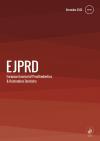European Journal of Prosthodontics and Restorative Dentistry
Water as Veneering Modeling Liquid Affects Microhardness of Glassy Matrix Veneering Ceramic
Abstract
Purpose/Aim: To evaluate the effect of different veneering liquids used for modeling on microhardness, fracture toughness and biaxial flexural strength of a glass-veneering ceramic. Material and methods: The manufacturer recommended modeling liquid (ML), distilled water (DW), isopropyl alcohol (IA), 0.5% (P05), 1% (P1), and 2% (P2) polyethylene glycol solutions were mixed with feldspathic ceramic powder to form disc-shaped samples (n=20, 15 mm × 1.2 mm). After sintering, samples were mirror-polished and subjected to Vickers indentation (n=5) for measurement of microhardness and fracture toughness. The remaining 15 samples from each group were subjected to biaxial flexural strength. Data were subjected to one-way ANOVA and Weibull analysis. Results: The microhardness was affected by veneering liquid (p=0.002): DW promoted higher microhardness values than ML and IA. Fracture toughness (p=0.301) and flexural strength (p=0.930) were not affected by the veneering liquid but Weibull parameters were affected. All groups presented surface pores under high magnification. Conclusion: Even though the use of DW led to higher values of surface microhardness than the ML, all obtained values are inside the range of
enamel microhardness values reported in the literature. Such parameters may affect antagonist wear and should be reported in clinical trials.
Keywords
Polyethylene Glycol
Porcelain
Modeling Liquid
Authors
Marina Amaral, Tiago M. B. Campos, Talita Takahashi, Gabriely S. D. Moura, Gabriela F. Ramos, Renata M. D. Melo, Mutlu Özcan
Articles from this issue
 Free Access
Free Access No Access
No Access Full Access
Full Access


